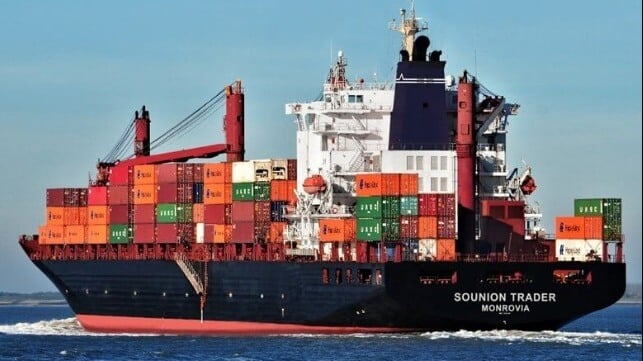British Start-up Completes Sea Trial of Onboard Carbon Capture System

The UK-based climate tech start-up Seabound recently released the results of its trial of shipboard carbon capture technology. The sea trial of the technology began last September as a crucial step in commercializing a cost-effective method of reducing emissions on board vessels.
The pilot was supported by global shipping companies including Lomar Shipping, and its subsidiary Lomarlabs, as well as Hapag-Lloyd, Columbia Shipmanagement, and the UK Government, among others. The onboard carbon capture system (OCCS) was tested in a 3,200 TEU vessel, the Sounion Trader which is owned by Lomar and currently operated by Hapag-Lloyd. The vessel was built in 2003 and is 40,478 dwt. Before the trials began, Seabound received a class society approval for installation and testing of the device from the American Bureau of Shipping (ABS), with the project also approved by Liberia, the vessel’s flag state.
The trials took two months, while the vessel was on a route between Turkey and the Persian Gulf. During the period, the device captured CO2 at 80 percent efficiency and sulfur dioxide at 90 percent efficiency.

The company promotes that its system is compact fitting inside a container and easy to retrofit (Lomar)
"While still early days, our pilot project proves that our technology works. This breakthrough demonstrates that the shipping industry doesn’t have to wait for new fuels or solutions to reduce its emissions in the future- we can start carbon capture from the existing fleet right now,” said Seabound co-founder and CEO Alisha Fredriksson.
The patent-pending compact carbon capture device by Seabound works by retrofitting it into a ship’s engine exhaust at the funnel. The CO2 chemically reacts with pebbles of quicklime, which then convert into limestone, keeping the CO2 locked in. The limestone pebbles are temporarily stored onboard and are later offloaded. They can be either sold in pure form or turned back into quicklime and CO2, with the quicklime to be reused for a similar carbon capture process and the CO2 sold for utilization or sequestration.
Following the successful pilot project, Seabound has announced that it will design a full-scale onboard carbon capture device that will capture 50 tons of CO2 per day. In addition, the company plans to deliver the first commercial systems to the market in 2025, with the expectation of scaling to three ships that year, and 10 ships by 2026.
Last month, the Liberian Ship Registry submitted the results of this pilot project to the International Maritime Organization (IMO), ahead of the eighty-first session of the Marine Environment Protection Committee (MEPC) scheduled for next month. The project will act as a case study of a successful onboard carbon capture, demonstrating that this new category of marine decarbonization technology is quickly emerging as an option for the industry.
